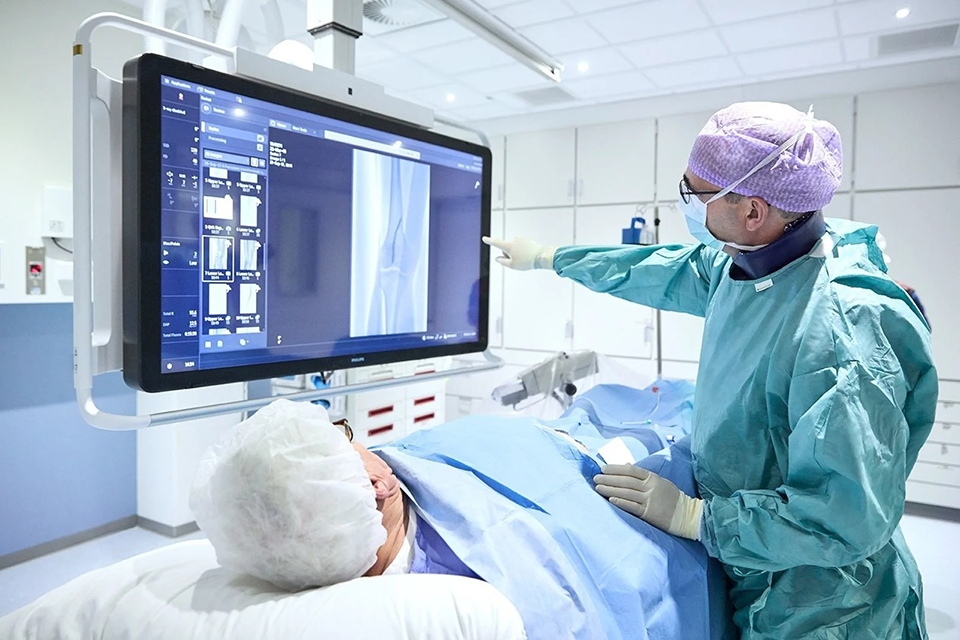The Power of Image-Guided Therapy in Healthcare
Discover how Image Guided Therapy is transforming the healthcare industry and improving patient outcomes.
4 min read
Domico Med-Device May 07, 2024
In the realm of modern medicine, where precision and efficacy reign supreme, image-guided therapy (IGT) stands tall as a beacon of hope for patients and healthcare providers alike. This cutting-edge approach, driven by advancements in medical imaging technologies such as computed tomography (CT) and magnetic resonance imaging (MRI), has revolutionized the landscape of treatment across various medical disciplines, particularly in interventional radiology and radiation therapy.
 What is Image-Guided Therapy?
What is Image-Guided Therapy?Image-guided therapy, often abbreviated as IGT, encompasses a wide array of minimally invasive procedures that are guided by cutting-edge real-time imaging techniques. These innovative procedures leverage high-resolution imaging systems such as CT and MRI to navigate through the intricate pathways of the body with unparalleled precision. By utilizing these advanced imaging technologies, healthcare professionals are able to hone in on specific areas of concern with remarkable accuracy, all while safeguarding the integrity of surrounding healthy tissue. This groundbreaking approach not only enhances the effectiveness of treatments but also minimizes the impact on the patient's overall well-being, marking a significant advancement in the realm of modern medicine.
The advent of medical imaging has indeed revolutionized the landscape of healthcare, ushering in a new era of precision and personalized treatment approaches. With the emergence of cutting-edge technologies like CT and MRI, healthcare providers now have at their disposal indispensable tools that offer detailed insights into the intricate workings of the human body. These imaging modalities not only provide a window into the anatomical structures but also reveal functional information essential for tailoring therapeutic interventions to meet the unique needs of each patient. As medical imaging continues to evolve, it has become a cornerstone in diagnostics and treatment planning, paving the way for more effective and individualized healthcare interventions.
Interventional radiology (IR) is a dynamic field that utilizes the precision of image guidance to perform a wide range of minimally invasive procedures for various medical conditions. By leveraging advanced imaging technologies such as CT and MRI, IR techniques offer patients innovative alternatives to traditional surgery. Whether it's catheter-based interventions to manage vascular conditions or tumor ablations to target cancerous growths, IR procedures not only reduce the risks associated with invasive surgeries but also lead to shorter hospital stays and quicker recovery times for patients. This transformative approach to medical intervention highlights the incredible potential of image-guided therapy in revolutionizing patient care and improving treatment outcomes.
 Enhancing Radiation Therapy with Image Guidance
Enhancing Radiation Therapy with Image GuidanceImage-guided radiation therapy (IGRT) has emerged as a cornerstone in the delivery of precise radiation treatments for cancer patients. By integrating imaging technologies into treatment sessions, radiation oncologists can monitor tumor response in real-time, adapt treatment plans accordingly, and minimize radiation exposure to surrounding healthy tissues. This dynamic approach not only allows for the precise delivery of radiation to target tumors with unprecedented accuracy but also enables clinicians to make real-time adjustments based on the tumor's response, ultimately optimizing treatment outcomes. Through the seamless integration of imaging technologies, IGRT empowers healthcare providers to tailor radiation therapy plans to each patient's unique anatomy and disease characteristics, ensuring the highest level of care and efficacy in cancer treatment.
This collaborative approach in image-guided therapy not only ensures seamless coordination throughout the treatment journey but also fosters a dynamic environment where expertise from various disciplines converges to provide the highest level of care. Radiologists bring their expertise in interpreting imaging studies, oncologists offer insights into cancer treatment strategies, physicists contribute their knowledge of radiation therapy principles, and allied healthcare professionals provide essential support to ensure the smooth delivery of care. Together, these multidisciplinary teams work in synergy, pooling their collective knowledge and experience to tailor individualized treatment plans that address the unique needs of each patient. From the initial diagnosis to post-procedural care, this collaborative effort forms the backbone of image-guided therapy, ultimately leading to improved treatment outcomes and enhanced patient satisfaction.
Image-guided therapy accommodates a diverse range of radiation modalities, each tailored to address specific nuances of tumor characteristics and patient needs. External beam radiation therapy (EBRT) delivers high-energy radiation beams externally to target tumors with precision, making it ideal for treating larger or deep-seated tumors. Brachytherapy, on the other hand, involves the internal placement of radioactive sources directly into or near the tumor site, allowing for a concentrated dose of radiation to be delivered while minimizing exposure to surrounding healthy tissues. This approach is particularly effective for treating localized cancers, such as prostate or cervical cancer. Stereotactic body radiation therapy (SBRT) utilizes highly focused radiation beams from multiple angles to deliver a precise and intense dose of radiation to the tumor, making it well-suited for treating small, well-defined tumors or metastases. By offering a spectrum of radiation modalities, image-guided therapy ensures that treatment plans are tailored to each patient's unique circumstances, maximizing the chances of successful outcomes and minimizing potential side effects.

In addition to its remarkable precision in targeting tumors, image-guided therapy brings a myriad of advantages to patients, transcending mere treatment efficacy. By significantly reducing procedural complications, shortening recovery times, and enhancing overall quality of life, IGT embodies a holistic approach to healthcare that prioritizes patient well-being. Through its minimally invasive nature and meticulous preservation of healthy tissue, image-guided therapy not only improves treatment outcomes but also fosters a sense of empowerment and reassurance for individuals navigating the complexities of illness. By placing patient satisfaction and holistic wellness at the forefront, IGT emerges as a beacon of hope and healing, guiding patients toward a brighter and healthier future.
As technology continues to advance, the future of image-guided therapy holds even greater promise. The integration of artificial intelligence algorithms for real-time image analysis is set to revolutionize the field, allowing for rapid and accurate interpretation of complex imaging data. By harnessing the power of AI, healthcare providers can streamline decision-making processes, optimize treatment plans, and ensure the highest level of precision in patient care.
Furthermore, the development of novel imaging modalities with enhanced resolution and functionality promises to push the boundaries of IGT even further. Emerging technologies such as advanced molecular imaging and functional MRI hold the potential to provide unprecedented insights into disease processes at the cellular level, paving the way for more targeted and personalized treatment strategies. With ongoing research and innovation driving these advancements, the future of image-guided therapy is poised to deliver even more tailored and effective care to patients, ushering in a new era of precision medicine and improved outcomes.
In the realm of modern healthcare, image-guided therapy stands as a testament to the power of innovation in improving patient outcomes and transforming treatment paradigms. By harnessing the capabilities of advanced imaging technologies, healthcare providers can navigate the complexities of disease with unprecedented precision, offering patients hope and healing on their journey towards recovery. As we continue to push the boundaries of medical science, the future of image-guided therapy shines bright with possibilities, paving the way for a healthier and more vibrant tomorrow.

Discover how Image Guided Therapy is transforming the healthcare industry and improving patient outcomes.

In our ongoing series on optimizing hybrid operating rooms (ORs) for patient benefit, we've explored the fundamental aspects of these advanced...

Image-guided therapy (IGT) represents a transformative approach in modern medicine, combining advanced imaging techniques with therapeutic...